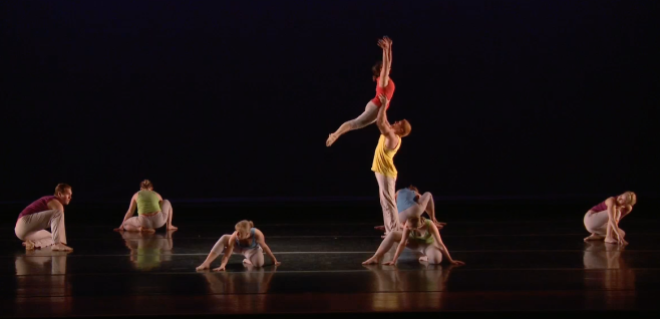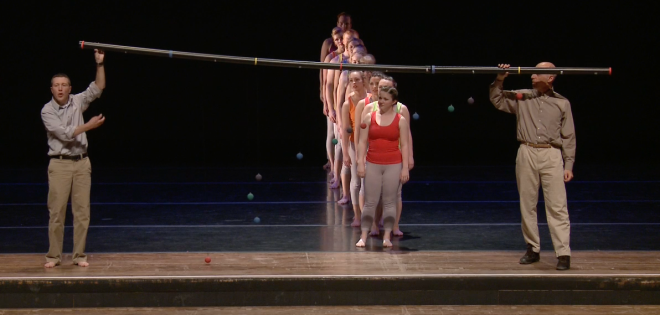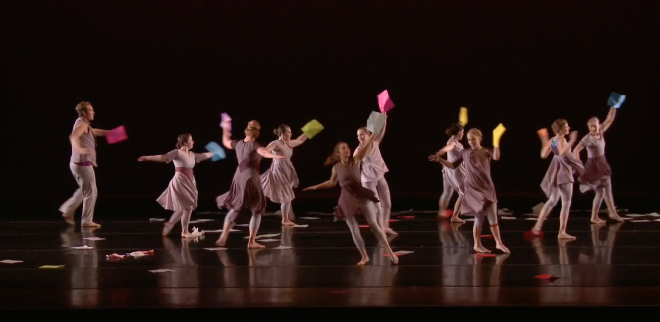One of the features we especially love about A Body in Motion is that any individual can see, feel, and imagine lots of different concepts and themes. Perhaps this is most obviously true for the dance side of things — the arts are supposed to be open to interpretation. But we think this is also true for the science. There are some basic themes and concepts that we have in mind, but there is no one preordained principle or particular observation that you should be seeing at any particular time. It’s fun to get people together to compare all the different ideas that they associate with the piece as a whole or with any of the specific phrases within.
I’ve put together the following description, not as “The Guide,” but as a brief on one scientific interpretation behind the piece. In this case, it happens to be my (Adam’s) scientific interpretation. We hope that this can be a sort of recap of A Body in Motion and many of the ideas within, and even more we hope that this gives a starting point for other discussions. We would be thrilled to hear more of your own ideas in the comment section below, because there’s certainly more to see.
A Body in Motion is comprised of 4 major parts, although these are meant to blend from one to the next. (By the way, what you probably don’t notice is that many of the phrases and interludes are timed very deliberately as dancers are running around backstage in the dark, dealing with costume changes, prop setups, and even stage lighting.) We have ideas that are built on one another, and arcs that allow us to revisit some themes that are being developed.
You can use this video of a performance to provide examples of the science described below.
A Preface
The performance starts with an electric cord being pulled out onto the stage by a dancer. (A vaguely lit lump is lying to the side, but he’s just a physicist in “zeroth position” and can be ignored.) The cord demonstrates at least two things. First, there’s the idea of how energy is transferred through the cord in multiple ways, especially through waves. Waves are a way of getting energy through stuff without actually displacing the stuff. While the cord moves up and down, the only thing that’s moving from one end of the cord to the other is energy. This is the case in all kinds of waves, such as earthquakes, waves on the ocean, etc., and especially (for our purposes) sound, which we get to play with later.
Most Astounding Facts
The first cohort of dancers to come onto stage surrounds an alarmed and truly terrified physics teacher. This is where we get the first introduction to our use of paper and the many ways that it can be manipulated. It tells us something about the nature of matter, how things interact (e.g., with friction), and especially how the paper moves through the fluid of air that is surrounding all of us. This is just an introduction, and we get to play with this quite a bit more throughout the performance.
By the time the physics teacher makes his way out of the circle, he gets to start imaging some “most astounding facts,” which leads into a recorded interview of Neil deGrasse Tyson describing other “most astounding facts.” We point out that the facts aren’t really that important throughout this piece, but there are some that are truly astonishing that we like to see reflected in this piece.
First, there’s this notion that “the universe is in us.” Our solar system, planet, and everything that composes our very selves is assembled from “second generation” ingredients. That is, another super massive star had to live out its life, take the original lightweight ingredients of the universe, fuse them into the heavier stuff (carbon, nitrogen, oxygen, etc.), and then explode. That debris got reassembled into our solar system, and eventually to us. The original universe didn’t have the right ingredients to make anything more complex than helium or hydrogen. So, our own physical essence have already been in the heart of another faded star before it could become us. (Carl Sagan is famously quoted saying that this means we are all composed of stardust.)

Dancers are starting to play with geometries and pairings of forces. (Click on the image for a larger version.)
In the same section, the narration describes Newton’s coming to understand the mechanisms of the natural world, including motion and gravity. He put these together to explain the elliptical orbits of planets around the Sun — demonstrated by the dancers themselves. That ellipse is a very specific geometrical shape, but the only force that makes it happen is the gravity from the Sun. Newton’s greatest legacy, perhaps, is that he was able to take rules of nature that we understand here on Earth (laws of motion) and apply them to planetary objects to predict their orbits. It showed that the rules of nature aren’t just in one place — they’re everywhere, universal.
Observation, Experience, and Play
After these “facts,” we transition to show the playfulness of experiment. On one side of the stage, you see some people experimenting with how air can be moved, and how we can trace out the motion of this fluid by watching other objects (foam peanuts, paper, fabric). On the other side of the stage you see dancers playing with their pieces of paper. Each group is aware of one another, because they are doing the same things, making observations and getting new ideas about what to do next. In all of our work with dance and science, we’ve found that this kind of play is something that both share, even though their purposes are different.
As the experiment sequence closes, a dancer comes out onto the stage with a leaf blower. Frankly, the idea of a leaf blower in the midst of a dance performance intrigued us so much that we keep finding ways to bring it back into the performance. Again, we like the playing. This provides a clear contrast between the aesthetics of the dancers and the intrusion of the power tool. It also makes it very clear that we’re playing with matter, even though the matter we’re interacting with the most is the air in the room. In this case, you get to see how the air stream from the blower can levitate a beach ball. The flowing air creates an area of low pressure compared to the still air around us, and the ball can naturally get stuck there, pushed in by the higher pressure, non-moving air. This is actually something we attribute to Bernoulli’s Principle, which is described by dancers in the following sequence.
Investigations
All this playing leads us to a novel interlude in the performance where the performer-audience wall is broken a bit. Erik and I introduce to the audience the idea that we are going to collect data, and specifically that we’re going to study the swinging motion of pendulums. This investigation relies on the audience to count how many times each dancer’s pendulum swings in 10 seconds. We then hang the pendulums, each of a different length, from a physical number line that “stores” the number of swings for each of these devices.

Pendulums are hung as a graph, according to how many times they’ve swung in 10 seconds. (Click on the photo for a larger image.)
If everyone collects good data and records it properly, we create is a pattern that shows a smooth curve, longest strings with the fewest swings progressing to the shortest strings with the most swings. This is an interesting relationship, in which each progressively shorter string seems to get a little extra credit in terms of how many swings it gets. That is, the ratio between the string length and the number of swings isn’t constant, but actually continues to change. This produces an interesting curve that actually shows a mathematical function — produced by the natural world. I get jumping-up-and-down-excited about this: Nature creates an equation and graphs it for us! We make the point that in science we look for these patterns, and in dance we put these patterns to good use. We show this by having each dancer emulate the motion of their respective pendulum, and we see the dancers all moving at different paces, and scattering off the stage in their own resulting pattern.
Erik kicks the balls off stage while I try to move them using the leaf blower. I’d just like to point out that this is really hard to do accurately, but it’s fun to try.
Forces and Systems
The next section involves three pairs of dancers coming on and off stage, accompanied by particularly percussive music. (This is the only section by a choreographer other than Erik. Many thanks to Peggy Gaither for contributing her choreography.) There are a series of really impressive holds, pushes, pulls, and motions. These all demonstrate interesting pairings of forces, both balanced and imbalanced.

Dancers rely on one another to create a system of balanced forces. (Click on the image to see a larger version.)
All of these forces are “paired.” This is described by Newton’s 3rd law: forces come in pairs, or for every force there is an equal and opposite force, or for every action there is a reaction. You can really see this with the dancers as the push on one results in an opposite push from another. But we probably too often take this for granted. Every force in the universe is accompanied by another force that just happens — no one has to think about it or deliberately make it so. And, every time one force is created, the other force has exactly the same quantity. Nature does not have to work this way, but it does, and the universe is what it is because of this.
Erik and I come out to reevaluate the ideas in these pairs by watching a trio of dancers doing similar choreography. We wonder out loud what we’re looking at. There’s motion, balance, forces, etc. But there’s also other big ideas that we use in both art and science: flexibility, variation, structure, etc., in all meanings of these words.
We move from this to a question about all the things that we don’t know, and how we ask questions. Erik asks us to think about something that we see all the time, but maybe one day see in a whole new way. I get to interrupt by smacking the end of a pipe with a flip-flop. We demonstrate how changing the length of the pipe also changes the pitch of the sound. This gets back to the nature of waves: each length of pipe fits a very specific sound wave, and so a very specific pitch. This also relates to the pendulums: each length has a very specific pace. Erik imagines that this is something that’s useful in the design of anything from an engineered structure to a musical instrument; and I realize that it isn’t the facts that are important here, but the way we imagine, invent, and wonder.
This all leads to the introduction of the Booch, an instrument that is created out of different lengths of tubes and played with flip flops. We really can put these basic ideas to use in interesting and creative ways.
Air: Matter and Space
Erik play the Booch just long enough to let the dancers setup for the final piece, A Piece of Paper (as we whimsically call it). We’ve also embraced an observation (by Brad Carroll, WSU Physics) that this piece makes it look like the dancers are surrounded by a fluid, almost swimming around in it. Of course, we all know that air is around us, but this section makes us especially aware of it. So, we’ve come to refer to this section as the “Air Aquarium” (or perhaps the “Aeroquarium,” or maybe the “Aerorium”). We don’t know exactly which one of those is the most catchy or accurate, but you get the idea.
As we watch the dancers play with pieces of paper, it becomes increasingly clear that there are all kinds of things to do with a piece of paper, and there are all kinds of things that it tells us about our surroundings. More importantly, it gives us new questions to ask: What determines the motion of the paper? how does the paper stay stuck to someone’s hand if they aren’t gripping the paper? In some cases this depends on air, but in others not so much. We invite everyone who sees this performance (or even anyone who doesn’t) to try to play with the paper, feel what it takes to move the paper in the palm of your hand without actually gripping it. You probably have an easy time doing this when your hand is under the paper, but what about when it’s at the side? And, if you watch closely, you’ll see that some of our dancers can actually make the paper seem to surf on the air, with their hand on top of the page. This looks creepy and maybe even a little faked, but we promise that it’s all real. (It takes practice, but you should try it!)

Dancers are watching Ryan “surf” paper on the air before they imitate the practice for themselves. (Click on the image for a larger version.)
Throughout this final paper piece we see other ideas brought back. The dancers actually have a wave travel through them at several points. They do experiments with their own pieces of paper that are inspired by and inspire others on the stage. And, all the while, they use the paper to describe the motion of objects through a fluid, as well as modeling a bit about how particles of matter might move in different ways. You could think of the dancers themselves as these particles at the microscopic level; but then you can switch perspectives and recognize that the paper is moving through a fluid of particles as well.
This section transitions as we put all of my skills to good use, utilizing a leaf blower again. I get to blow paper off stage, but also we get to see how this imagery informs the dance and the motion of the dancers as they are blown off the stage as well. Dancers come back to the stage as what we call the “flawed walkers.” Three dancers come out walking unimpeded, but as other dancers add paper to them we can imagine them being bogged down with more inertia. There are lots of alternative ideas that this evokes as well, and we like it that way.
Conclusion
The last section celebrates all the components of the entire piece. Erik’s Booch playing skills get highlighted, using waves in each of those tubes. Dancers use the paper in a synchronized, structured (but still playful) manner, building from all their previous experiences with the paper, with the space around them, with motion, and with what results from asking lots of questions. In short, this revels in what we can create when science and art play off of one another.

Multiple themes come together at the end of A Body in Motion. (Click on image for a larger version.)
This is what I see as I’ve worked with our dancers and Erik. But there’s more to be seen. You’re welcome to add your own observations below.
